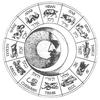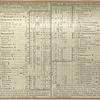5: An illustration of the Jewish calendar, 1973, and an archival Russian train schedule, Saint Petersburg–Vitebsk line, 1908.
If you take another look at the first activity in this resource kit—the “map” exercise—you’ll notice that what is common to all the layers of the narrative in “On Account of a Hat” is their timing. Always, in each layer, it is the eve of Passover: Sholem Aleichem’s story in the Yiddish original is subtitled “a mayse lekoved peysekh” (“a tale on the occasion of Passover”) and is one of numerous stories that Sholem Aleichem wrote for specific Jewish holidays; the merchant from Kasrilevka tells Sholem Aleichem that “[i]t’s a pity [that he is] in such a hurry on account of the Passover”; Sholem Shachnah Rattlebrain tries to get home in time for Passover, and the Kasrilevka merchant relays this story to Sholem Aleichem on the eve of Passover as well; Sholem Shachnah’s nightmare of not being able to get home, which he dreams up while he is asleep at the train station on Zlodievka, is also set on Passover eve.
Passover in “On Account of a Hat” is not merely a single occasion or a holiday, but a way of thinking about time. “On Account of a Hat” stages a kind of dramatic clash between two entirely different ways of understanding how time works.
On the one hand, there is “Jewish time”—the time marked by the Jewish holidays that occur at the same time of the year every year, at regular intervals as specified by religious sources such as the Hebrew Bible. In “On Account of a Hat,” events unfold on the eve of Passover, one of the most important holidays in the Jewish year. The Jewish year itself unfolds according to a lunar calendar, in which the changing of months is tethered to the cycles of the moon and the changing of the seasons and agricultural cycles in nature: Passover always occurs in the spring, a time of renewal. The multiple narratives in “On Account of a Hat” all occur at what the Yiddish language may colloquially refer to as peysekh-tsaytns—Passover time.
On the other hand, “On Account of a Hat” also runs according to what is customarily known as “railroad time” or “railway time.” First introduced in England in November of 1840, railway time was the standardized time necessary to operate an expanding network of trains; prior to the construction of railroads and the standardization of time, different towns would observe less formal local conventions of time—marked, for example, by a sundial. As railroad networks began to expand, time became standardized so that passengers in different towns could know when the trains were going to arrive and depart (and so that trains didn’t crash into each other while en route).
Suggested Activity:
- First, scan the story and make a list of all references to Passover and particularly of references to Passover in terms of time, as an event that is imminently around the corner. Look at the illustration of the Jewish calendar. It is a circle and Passover, no matter how much time a person might need to get home, will arrive when it must no matter what, as the yearly cycle rotates the way it always has and always will—the start of Passover, in other words, cannot be delayed. Put yourself in Sholem Shachnah’s shoes—or, for that matter, in the shoes of the Kasrilevka merchant or Sholem Aleichem: what kinds of feelings would you experience if you desperately wanted to get home in time for Passover, which is about to begin, so you can spend the holiday with your family?
- Second, scan the story and make a list of references to the train, especially its schedule and timing. How does the merchant from Kasrilevka think about the extension of the rail line from the main railroad to his small hometown that had, before the arrival of the train, been in the middle of nowhere? What kind of schedule is the Kasrilevka train supposed to run on—and how is the planned schedule different from the train’s actual schedule in terms of the experience of passengers? Consider the Russian imperial train schedule from 1908. Note how the passengers have to read this timetable linearly (from top to bottom, in the case of this particular train schedule), noting the progress of the train according to specified intervals of time as it moves forward from one station to another.
- Now, put yourself in Sholem Shachnah’s shoes again: what do you think Sholem Shachnah experiences as he is caught between the two ways of understanding time—the cyclical calendar of Jewish holidays and the linear calendar of the train? As Sholem Shachnah tries to get home for Passover—an imperative based on the cyclical calendar of traditional Jewish observance—the train moves on an entirely different schedule that is in no way tethered to Passover and Jewish time. How might we think about the stakes involved in making this journey—especially if trains on Sholem Shachnah’s route are known to be delayed?
Sources: The First Jewish Catalog, eds. Richard Siegel, Michael Strassfeld, and Sharon Strassfeld (Philadelphia: Jewish Publication Society of America, 1973), 99.
Archival Russian train schedule, 1908, from the website of Pskov Railways, http://www.pskovrail.ru/2008/059_060v_Peterburg_Vitebsk.jpg.
Jewish_calendar.jpg
 Download image (452.66 KB)
Download image (452.66 KB) 059_060v_Peterburg_Vitebsk.jpg
 Download image (442.59 KB)
Download image (442.59 KB)


